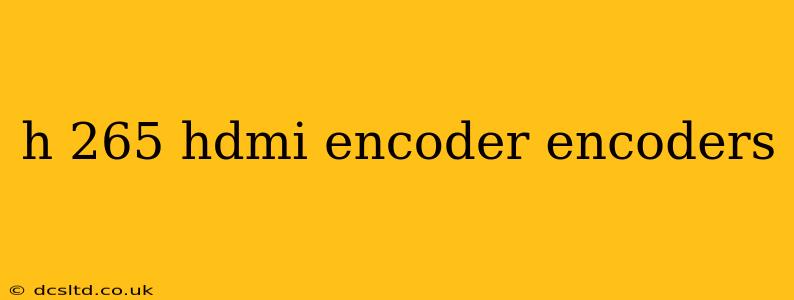The world of video encoding is constantly evolving, and H.265 (also known as HEVC - High Efficiency Video Coding) has become a crucial player. This advanced codec offers significant advantages over its predecessor, H.264, particularly in terms of compression efficiency. When paired with HDMI input, H.265 HDMI encoders become a powerful solution for a range of applications, from live streaming to security systems. This guide will delve into the specifics of H.265 HDMI encoders, exploring their features, benefits, and considerations for choosing the right one.
What is an H.265 HDMI Encoder?
An H.265 HDMI encoder is a device that takes an HDMI video signal as input and converts it into a compressed H.265 video stream. This compressed stream can then be transmitted or stored more efficiently than uncompressed video. Think of it as a translator, converting the high-resolution, large-file-size HDMI signal into a smaller, more manageable H.265 format. The encoding process reduces the bandwidth required for transmission and the storage space needed for archiving.
Why Choose H.265 over H.264?
H.265 boasts superior compression capabilities compared to H.264. This translates to:
- Smaller File Sizes: Achieves the same video quality with significantly smaller file sizes, resulting in lower storage costs and reduced bandwidth consumption.
- Higher Resolution Support: Handles higher resolutions (like 4K and 8K) more efficiently than H.264.
- Improved Efficiency: Requires less bandwidth for the same video quality, making it ideal for streaming and network-based applications.
What are the Key Features of H.265 HDMI Encoders?
High-quality H.265 HDMI encoders typically include a range of features, including:
- HDMI Input: Accepts various HDMI resolutions and frame rates.
- H.265 Encoding: Utilizes the H.265 codec for efficient compression.
- Network Connectivity: Supports various network protocols like RTMP, RTSP, and ONVIF for easy streaming and integration.
- Adjustable Bitrate and Resolution: Allows customization of the output stream to match specific bandwidth and quality requirements.
- Audio Encoding: Often includes support for various audio codecs like AAC and MP3.
- Multiple Streaming Options: Some encoders allow simultaneous streaming to multiple platforms.
- Remote Control and Management: Many offer remote control and management capabilities via web interfaces or dedicated software.
What are the Applications of H.265 HDMI Encoders?
The versatility of H.265 HDMI encoders makes them suitable for a wide range of applications:
- Live Streaming: Streaming events, conferences, and gaming sessions to platforms like YouTube, Twitch, and Facebook Live.
- Video Surveillance and Security: Recording and transmitting high-quality video footage from security cameras.
- Digital Signage: Displaying dynamic content on large screens in public spaces.
- Video Conferencing: Facilitating high-definition video conferencing over networks.
- Broadcast Applications: Contributing high-quality video feeds to broadcast systems.
- Medical Imaging: Transmitting and archiving high-resolution medical images.
How to Choose the Right H.265 HDMI Encoder?
Selecting the optimal H.265 HDMI encoder depends on your specific needs. Key factors to consider include:
- Input Resolution and Frame Rate: Ensure compatibility with your source device's output.
- Output Bitrate and Resolution: Determine the required bandwidth and quality for your application.
- Network Connectivity: Choose encoders supporting your preferred network protocols.
- Features: Consider additional features such as audio encoding, multiple streaming options, and remote control capabilities.
- Budget: Set a budget and compare features across different models.
What are the Different Types of H.265 HDMI Encoders?
H.265 HDMI encoders come in various form factors, including standalone hardware units and software-based solutions. Standalone units offer plug-and-play convenience, while software solutions might offer more customization but require more technical expertise.
What is the difference between H.264 and H.265 encoding?
The primary difference lies in compression efficiency. H.265 achieves significantly better compression ratios than H.264, meaning smaller file sizes for the same visual quality, or better quality at the same file size. This translates to reduced bandwidth requirements and storage needs.
How much bandwidth do I need for H.265 encoding?
The bandwidth required depends heavily on the chosen bitrate and resolution. Higher resolutions and bitrates demand more bandwidth. Generally, H.265 is more efficient than H.264, so you may require less bandwidth to achieve the same quality. Consult the encoder's specifications and your network's capabilities.
Can I use an H.265 encoder with my existing streaming setup?
Compatibility depends on your existing streaming setup. Ensure your streaming platform and other equipment support H.265 decoding. Some platforms might have limitations on the bitrate or resolution you can stream.
Conclusion
H.265 HDMI encoders offer a compelling solution for applications demanding high-quality video compression and efficient bandwidth usage. By understanding their features, benefits, and applications, you can choose the right encoder to meet your specific needs and enhance your video workflow. Remember to carefully consider factors like resolution, bitrate, network connectivity, and additional features before making a purchase.
